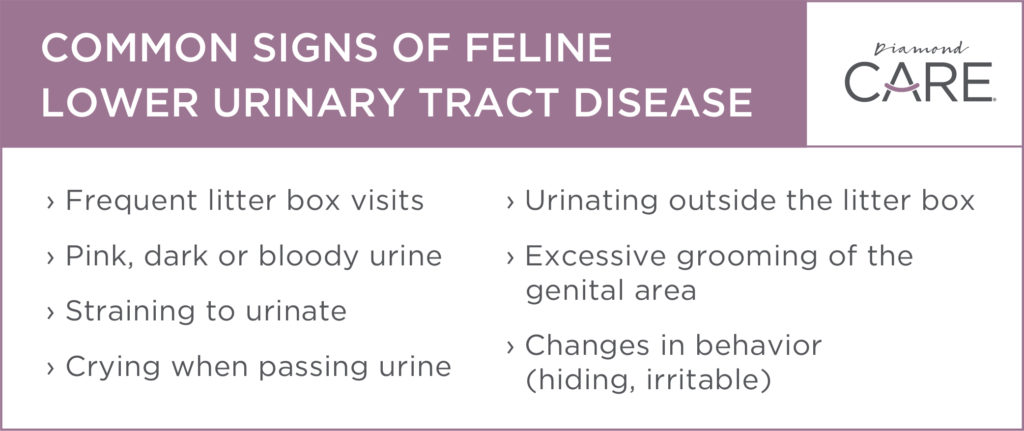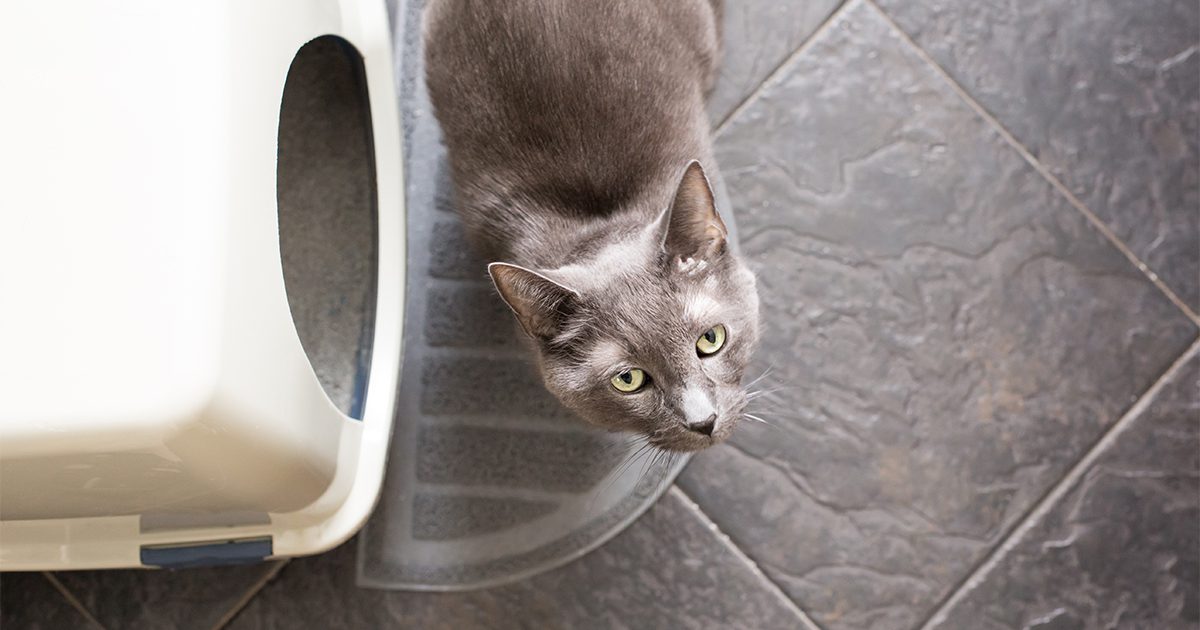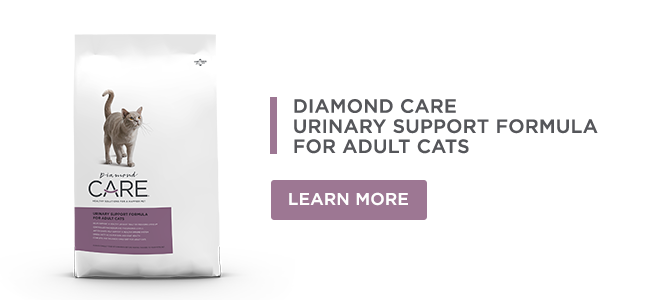Feline lower urinary tract disease affects an estimated 4.5 to 8 percent of cats, making it one of the more common medical issues affecting them. Often abbreviated FLUTD (and pronounced as one word, “fluted”), the term describes a group of conditions that affect the urinary bladder and/or urethra (the tube leading from the bladder to the outside of the body) and your cat’s ability to urinate or use the litter box normally. Read on to learn more about the signs, causes, diagnosis and treatment of FLUTD.
Common signs of lower urinary tract health problems
Cats with FLUTD typically experience one or more signs. If your cat has any of the following, you should talk with your veterinarian as soon as possible.
- Frequent trips to the litter box, often passing small amounts of urine
- Blood in the urine, which may appear as pink, dark or bloody urine
- Straining to urinate, sometimes crying out when urinating
- Urinating outside the litter box or in unusual or inappropriate places
- Excessive grooming of the genital area
- Behavior changes such as hiding, irritability, aggression or lack of energy
According to the American Veterinary Medical Association (AVMA), FLUTD is usually seen in middle-aged, overweight cats who don’t get enough exercise, use an indoor litter box, have limited or no access to outdoors, or eat a dry cat food. Other factors, including environmental or emotional stress, multi-cat homes and sudden changes in routine, may increase the risk for FLUTD.

Common causes of FLUTD
The most common medical causes of outside-the-box urination include:
- Idiopathic cystitis, an inflammation of the bladder with an unknown cause
- Bladder stones (urolithiasis)
- Bacterial urinary tract infection (UTI)
There are a handful of other, less-common causes, including urethral plugs, defects in anatomy, tumors of the urinary tract and injury to the urethra or spinal cord.
How is FLUTD diagnosed?
Because the symptoms of FLUTD have many different causes requiring different treatments, the condition can be challenging to diagnose. Your veterinarian will use a variety of diagnostics to identify what’s going on, starting with a physical exam and history that includes any recent changes in your kitty’s environment.
A thorough history is important because veterinarians now know that feline idiopathic cystitis (FIC) is the most common form of FLUTD, accounting for about two-thirds of FLUTD cases. Often, there is a connection between a sudden inflammation of the urinary tract and new stress-inducing conditions in the home. While the most common stressors are new pets, new people or moving to a new home, even a subtle change in routine stresses some cats.
After gathering a history and performing an exam, your veterinarian will want to collect a urine sample and take X-rays of your cat’s bladder. The urine sample allows your veterinarian to assess urine pH and concentration and to check for the presence of crystals, blood, white blood cells (an indication of inflammation) and bacteria that may be causing an infection. Diagnostic imaging, such as X-rays or ultrasound, enables your veterinarian to check for bladder stones or anatomic problems such as tumors or polyps.
FLUTD is a treatable medical condition
Once the underlying cause of your cat’s signs and symptoms has been identified, your veterinarian will develop a treatment plan that addresses your kitty’s individual needs. Nutrition is almost always an important part of FLUTD treatment. Feeding the right diet can help control mineral concentrations, maintain a healthy urine pH and help reduce inflammation. Cats with urinary tract conditions such as struvite bladder stones benefit from a specific therapeutic diet. In other cases, you can feed an over-the-counter specialty food like Diamond CARE Urinary Support Formula for Adult Cats. You also may need to feed several small meals during the day instead of one or two large meals.
Getting your cat to increase his or her water consumption is also important to managing FLUTD. Water should be clean, fresh and available at all times. Some cats may drink more if they have access to a pet water fountain.
Modifications to your cat’s environment can also play a key role in treating FLUTD, especially FIC. All indoor cats, but especially those with FIC, benefit from a stress-free environment that offers physical and mental stimulation. Things like a cat tree, scratching posts, safe places for retreat and rest, interactive toys and playtime with you can help reduce feline stress while providing stimulation and feelings of safety and security.
You may also need to rethink litter box management for a cat with FLUTD. Ideally, your cat should have access to an adequate number of litter boxes — usually one more than the number of cats in the home — with the type of litter that your cat prefers. Litter boxes should be placed in quiet areas of the house that your cat can easily access. Finally, you’ll need to clean your cat’s litter box daily. Depending on your cat, you may be scooping the litter box once or twice a day and completely changing the litter every week.
FLUTD is potentially a lifelong disease, and it’s impossible to completely prevent. To help protect your cat from developing a lower urinary tract disease, be sure to keep your kitty at an ideal weight and encourage exercise and water consumption. Environmental enrichment, reduced stress levels in the home and clean litter boxes can go a long way to improving your cat’s life.
RELATED POST: Common Pet Health Issues Affected by Nutrition, Part 2
RELATED POST: Diamond CARE Urinary Support Formula for Adult Cats








